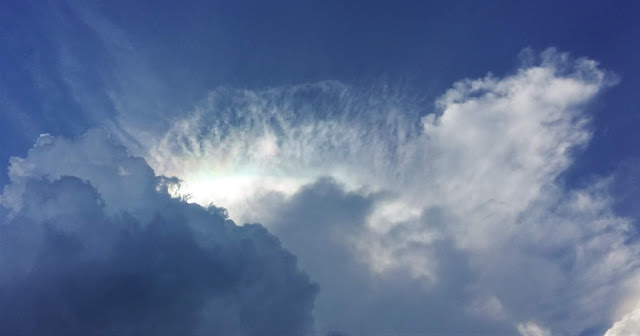I have just started walking into the jungle trail when from the corner of my eyes i spotted something high up on a dead tree. Moving a tad closer for a second look, i realised that it was a fish eagle but wasn't sure which one. There are two species of fish eagles which can be seen in this region. The other one is the Gray-headed Fish Eagle. Fearing that it might fly away like most raptors do (upon seeing humans), i quickly took a record shot.
This was the first shot of the raptor which local birders later identified it as a Lesser Fish Eagle. This is a resident but uncommon raptor in this region. The last sighting of this eagle at this location (Ulu Langat, Selangor) was in 2018 while the earliest was in 2016.
 |
| Lesser Fish Eagle |
Moments later it did 'flew' away but luckily to an adjacent branch on the same tree. Thereafter it perched on the same branch until the cows came home.
Note the upperside of its tail which is dark and does not clearly show a white base with a black terminal band of a Gray-headed Fish Eagle (Wells, 1999, Jeyarajasingam & Pearson, 2012 and Robson, 2015). In short there is no well demarcated tail band.
According to Jeyarajasingam and Pearson (2012), this raptor does not soar much like others. So this means it probably hunts from perch to perch.
Due to the difficult terrain and thick bushes surrounding the area, i could only moved just a few feet closer from my initial spot.
OTHER REFERENCES
1) David R. Wells (1999) The Birds of the Thai-Malay Peninsula (Non-Passerines). London: Academic Press.
2) Jeyarajasingam, A and Pearson, A (2012) A Field Guide to the Birds of Peninsular Malaysia and Singapore (2nd Ed.), Oxford: Oxford University Press
3) Robson, C (2017) Birds of South-East Asia, London: Helm
Note the upperside of its tail which is dark and does not clearly show a white base with a black terminal band of a Gray-headed Fish Eagle (Wells, 1999, Jeyarajasingam & Pearson, 2012 and Robson, 2015). In short there is no well demarcated tail band.
This one should be an adult bird as juveniles are reported to have more brownish feathers.
The only thing that moves was its head and occasional its legs.
Note its wedge-liked tail shape when perched. Local malay name for this raptor is "Lang Kanguk". Luckily it is not called "Lang Kangkung" which means it would prefer to eat "Kangkung" (a kind of water spinach) rather than fishes.
One leg up depicts a relax and calm demeanour (in the avian world). In the human world one leg up means you are in big trouble.
According to Jeyarajasingam and Pearson (2012), this raptor does not soar much like others. So this means it probably hunts from perch to perch.
The short whithish eyebrow / supercilium which was described by Wells (1999) can be seen here.
Due to the difficult terrain and thick bushes surrounding the area, i could only moved just a few feet closer from my initial spot.
Hence most of the photos here were heavily cropped (i.e about 95%)
This is how the bird looks like from a distance. Photo was cropped about 10 %.
So blessed to see this uncommon eagle.
OTHER REFERENCES
1) David R. Wells (1999) The Birds of the Thai-Malay Peninsula (Non-Passerines). London: Academic Press.
2) Jeyarajasingam, A and Pearson, A (2012) A Field Guide to the Birds of Peninsular Malaysia and Singapore (2nd Ed.), Oxford: Oxford University Press
3) Robson, C (2017) Birds of South-East Asia, London: Helm



































